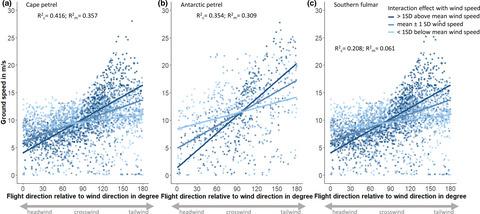当前位置:
X-MOL 学术
›
Ecol. Evol.
›
论文详情
Our official English website, www.x-mol.net, welcomes your
feedback! (Note: you will need to create a separate account there.)
Interactive effects of body mass changes and species‐specific morphology on flight behavior of chick‐rearing Antarctic fulmarine petrels under diurnal wind patterns
Ecology and Evolution ( IF 2.3 ) Pub Date : 2021-04-06 , DOI: 10.1002/ece3.7501 Nina Dehnhard 1, 2, 3 , Andrew R Klekociuk 2 , Louise Emmerson 2
Ecology and Evolution ( IF 2.3 ) Pub Date : 2021-04-06 , DOI: 10.1002/ece3.7501 Nina Dehnhard 1, 2, 3 , Andrew R Klekociuk 2 , Louise Emmerson 2
Affiliation

|
For procellariiform seabirds, wind and morphology are crucial determinants of flight costs and flight speeds. During chick‐rearing, parental seabirds commute frequently to provision their chicks, and their body mass typically changes between outbound and return legs. In Antarctica, the characteristic diurnal katabatic winds, which blow stronger in the mornings, form a natural experimental setup to investigate flight behaviors of commuting seabirds in response to wind conditions. We GPS‐tracked three closely related species of sympatrically breeding Antarctic fulmarine petrels, which differ in wing loading and aspect ratio, and investigated their flight behavior in response to wind and changes in body mass. Such information is critical for understanding how species may respond to climate change. All three species reached higher ground speeds (i.e., the speed over ground) under stronger tailwinds, especially on return legs from foraging. Ground speeds decreased under stronger headwinds. Antarctic petrels (Thalassoica antarctica; intermediate body mass, highest wing loading, and aspect ratio) responded stronger to changes in wind speed and direction than cape petrels (Daption capense; lowest body mass, wing loading, and aspect ratio) or southern fulmars (Fulmarus glacialoides; highest body mass, intermediate wing loading, and aspect ratio). Birds did not adjust their flight direction in relation to wind direction nor the maximum distance from their nests when encountering headwinds on outbound commutes. However, birds appeared to adjust the timing of commutes to benefit from strong katabatic winds as tailwinds on outbound legs and avoid strong katabatic winds as headwinds on return legs. Despite these adaptations to the predictable diurnal wind conditions, birds frequently encountered unfavorably strong headwinds, possibly as a result of weather systems disrupting the katabatics. How the predicted decrease in Antarctic near‐coastal wind speeds over the remainder of the century will affect flight costs and breeding success and ultimately population trajectories remains to be seen.
中文翻译:

昼夜风型下体重变化和物种特异性形态对南极暴海燕幼鸟飞行行为的交互影响
对于伞形海鸟来说,风和形态是飞行成本和飞行速度的关键决定因素。在雏鸟饲养过程中,海鸟父母会频繁地往返以供给雏鸟,它们的体重通常会在去程和回程之间发生变化。在南极洲,典型的日间下降风在早晨吹得更强,形成了一个自然的实验装置,可以研究通勤海鸟对风力条件的反应的飞行行为。我们通过 GPS 跟踪了三种密切相关的同域繁殖的南极海燕,它们的翅膀载荷和纵横比不同,并研究了它们对风和体重变化的飞行行为。这些信息对于了解物种如何应对气候变化至关重要。所有这三个物种在更强的顺风下都达到了更高的地面速度(即对地速度),特别是在觅食的返回途中。在更强的逆风下,地面速度降低。南极海燕( Thalassoica antarctica ;中等体重、最高翼载荷和展弦比)对风速和风向变化的反应比海角海燕( Daption capense ;最低体重、翼载荷和展弦比)或南方管鼻燕( Fumarus)更强glacialoides ;最高的体重、中等的机翼载荷和展弦比)。当外出通勤时遇到逆风时,鸟类不会根据风向调整飞行方向,也不会调整距巢穴的最大距离。然而,鸟类似乎会调整通勤时间,以受益于作为去程航段的顺风的强下降风,并避免作为返航航段的逆风的强下降风。 尽管鸟类对可预测的昼间风力条件进行了这些适应,但它们仍然经常遇到不利的强逆风,这可能是由于天气系统扰乱了下降。预计本世纪剩余时间内南极近岸风速的下降将如何影响飞行成本和繁殖成功以及最终的种群轨迹还有待观察。
更新日期:2021-05-04
中文翻译:

昼夜风型下体重变化和物种特异性形态对南极暴海燕幼鸟飞行行为的交互影响
对于伞形海鸟来说,风和形态是飞行成本和飞行速度的关键决定因素。在雏鸟饲养过程中,海鸟父母会频繁地往返以供给雏鸟,它们的体重通常会在去程和回程之间发生变化。在南极洲,典型的日间下降风在早晨吹得更强,形成了一个自然的实验装置,可以研究通勤海鸟对风力条件的反应的飞行行为。我们通过 GPS 跟踪了三种密切相关的同域繁殖的南极海燕,它们的翅膀载荷和纵横比不同,并研究了它们对风和体重变化的飞行行为。这些信息对于了解物种如何应对气候变化至关重要。所有这三个物种在更强的顺风下都达到了更高的地面速度(即对地速度),特别是在觅食的返回途中。在更强的逆风下,地面速度降低。南极海燕( Thalassoica antarctica ;中等体重、最高翼载荷和展弦比)对风速和风向变化的反应比海角海燕( Daption capense ;最低体重、翼载荷和展弦比)或南方管鼻燕( Fumarus)更强glacialoides ;最高的体重、中等的机翼载荷和展弦比)。当外出通勤时遇到逆风时,鸟类不会根据风向调整飞行方向,也不会调整距巢穴的最大距离。然而,鸟类似乎会调整通勤时间,以受益于作为去程航段的顺风的强下降风,并避免作为返航航段的逆风的强下降风。 尽管鸟类对可预测的昼间风力条件进行了这些适应,但它们仍然经常遇到不利的强逆风,这可能是由于天气系统扰乱了下降。预计本世纪剩余时间内南极近岸风速的下降将如何影响飞行成本和繁殖成功以及最终的种群轨迹还有待观察。











































 京公网安备 11010802027423号
京公网安备 11010802027423号